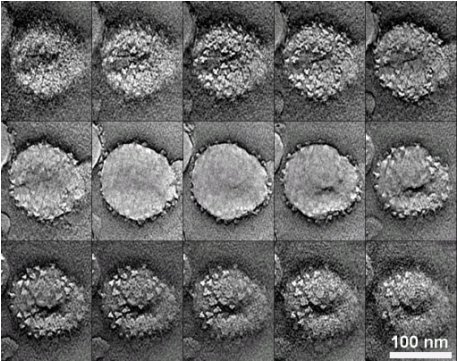The origins of the HIV virus have long been debated. However, its origins can be traced back to a place identified as Kinshasha, a small region in the Democratic Republic of Congo. This happened when a man with the same symptoms as AIDS died there in 1959. A small blood sample was collected from his remains and laboratory results showed that the man had a HIV infection. The reasons of his death was believed to be caused from complications caused by the viral infection. How he got infected remained a mystery but experts belief that they have unlocked the secret behind it. They believe that the disease was a form of Simian Immunodeficiency Virus (SIV.)
SIV (also known as African Green Monkey Virus) is a virus able to infect up to 33 different species of primates in Africa. Evidence shows that humans which participate in bushmeat activities, mainly hunters and vendors, commonly acquire SIV. The individuals concerned acquire the virus through exposure to the blood or other bodily fluids of the primates during hunting or butchering. Ingestion of meats from animals with SIV has also been known to transfer the virus to the consumer.This leads to the 'Bushmeat Theory' which suggest that Humman Immunodeficiency Virus (HIV) originated from SIV. Also, there are several different strains of HIV, indicating that perhaps that this cross-species transfer of virus has happened several times before. However, the evolution of SIV into HIV in humans is still a matter of debate, though natural selection would be the best answer where the virus has adapted itself to infect and reproduce in the T cells of humans.
Further study indicates zoonosis occurs in the emergence of HIV in humans from SIV in primates. The process which a pathogen is transfereed from an animal to a human is known as Zoonosis. For zoonosis to be able to occur, several conditions must be met mainly the presence of a human population nearby a population of host animals.This condition is met in the vast regions of Africa, mainly centralised in Rwanda, Uganda and the Democratic Republic of Congo (where previously in this article it has been stated the first case of HIV was detected). The next condition that must be met is the presence of an infectious pathogen which is able to transfer from the host animal to the human as well as a medium which the pathogen is able to do so. Again, both conditions are met with the presence of SIV in apes as well as the practice of bushmeat hunting and consumption by the human population in Africa, which affects hundreds of thousands of individuals allowing the virus to acquire a strong foothold. The next condition is that the virus is able to spread from human to human, which suggest that somewhere in between the transfer from ape to human, the virus has mutated to be able to transmit itself from human to human through several ways (please refer to overview). The last condition is that the virus has a way to spread widely, making prevention by provoking immunity in host or killing out the infected population inefficient. The lack of technology and resources as well as knowledge of the virus in more rural areas is a major supporting factor to the spread of HIV throughout the human population as well as the lack of measures to combat it. With this being said, it can be hypothesised that HIV originated from SIV , though the confirmation of this theory is yet to be assured, and most likely will take more years to come before being concluded.
HIV is thought to have been dispersed into the western hemisphere from Haiti to the United States in the late 1960's or early 1970's. HIV is thought to have arrived in Haiti from the Democratic Republic of Congo. The current theory is that HIV arrived in Haiti through an unkown individual or unkown individuals which may have once worked in the Democratic Republic of Congo circa 1966, or from other individuals which might have worked there. The virus eventually made its way to the United States through the gay communities in Large United States cities, where through a blend of unhealthy sexual practice (such as anal intercourse and the negliglence of proper protection during sexual intercourse) the virus spread rampantly. Because of the long incubation period of HIV, the virus was not detected until later on where at least 5% of the population had already been tested positive for the virus. The spread of the virus also leads to 'The Canadian Flight Attendant' theory where an air steward named Gaetan Dugas, which was theorised to have brought the virus along with him as he travelled. He was deemed 'Patient 0' in several studies of the origin of the virus. However, the theory is said to be inaccurate because HIV has already emerged before Dugas began his career.

Gaetan Dugas
Over the years, several other theories have been proposed to the origin of AIDS, some widely more accepted than others however all are being considered plausible sources of the virus. Here are a few of them:
1) The Hunter Theory (Also known as the Bushmeat theory): This is the most common and referred to as the most plausible origin of HIV. This theory denotes that HIV is a mutation of SIV (as explained in the paragraphs above) which was transferred to humans during hunting or butchering of primates as well as consumption of different meat. Everytime the virus passes on from a non-human primate to a human, the virus will change and result in different strains.

2) The Oral Polio Vaccine Theory: The theory states that the virus was transmitted through several medical experiments which were being carried out at the time, especially through polio vaccines. The vaccine for oral polio called Chat was given to millions in the Belgian Congo, Ruanda and Urundu in the1950's. The source of infection was theorised to be from kidney cells of chimps which were infected by SIV which were used to cultivate the vaccine. However, this theory was later rejected because only the liver cells of the macaque monkey, which cannot be infected by SIV was used in the production of Chat. Another reason that would possibly be related to the polio vaccine is that HIV already existed before the vaccine trials were carried out.

3)The Contaminated Needle Theory: At one point, African healthcare professionals were reusing syringes to inject multiple patients. This would allow SIV to be transmitted rapidly between individuals, followed up by the mutation of SIV into HIV
4)The Coloniliasm Theory: During the colonial rule in Africa, food was scarce and healthcare was poor in the work camps which many locals were forced into labor at. SIV could more than possibly have take advantage of their weak immune systems. Unsterilised syringes were also used to innoculate labourers with vaccines against diseases such as smallpox to keep them alive and in a state which they were able to work, which again, opens opportunity for infection. Many of the camps also actively employed prostitutes which assumably practiced unsafe sex to keep the labourers happy. All these factors may lead to the transmission and development of HIV.
SIV (also known as African Green Monkey Virus) is a virus able to infect up to 33 different species of primates in Africa. Evidence shows that humans which participate in bushmeat activities, mainly hunters and vendors, commonly acquire SIV. The individuals concerned acquire the virus through exposure to the blood or other bodily fluids of the primates during hunting or butchering. Ingestion of meats from animals with SIV has also been known to transfer the virus to the consumer.This leads to the 'Bushmeat Theory' which suggest that Humman Immunodeficiency Virus (HIV) originated from SIV. Also, there are several different strains of HIV, indicating that perhaps that this cross-species transfer of virus has happened several times before. However, the evolution of SIV into HIV in humans is still a matter of debate, though natural selection would be the best answer where the virus has adapted itself to infect and reproduce in the T cells of humans.
Further study indicates zoonosis occurs in the emergence of HIV in humans from SIV in primates. The process which a pathogen is transfereed from an animal to a human is known as Zoonosis. For zoonosis to be able to occur, several conditions must be met mainly the presence of a human population nearby a population of host animals.This condition is met in the vast regions of Africa, mainly centralised in Rwanda, Uganda and the Democratic Republic of Congo (where previously in this article it has been stated the first case of HIV was detected). The next condition that must be met is the presence of an infectious pathogen which is able to transfer from the host animal to the human as well as a medium which the pathogen is able to do so. Again, both conditions are met with the presence of SIV in apes as well as the practice of bushmeat hunting and consumption by the human population in Africa, which affects hundreds of thousands of individuals allowing the virus to acquire a strong foothold. The next condition is that the virus is able to spread from human to human, which suggest that somewhere in between the transfer from ape to human, the virus has mutated to be able to transmit itself from human to human through several ways (please refer to overview). The last condition is that the virus has a way to spread widely, making prevention by provoking immunity in host or killing out the infected population inefficient. The lack of technology and resources as well as knowledge of the virus in more rural areas is a major supporting factor to the spread of HIV throughout the human population as well as the lack of measures to combat it. With this being said, it can be hypothesised that HIV originated from SIV , though the confirmation of this theory is yet to be assured, and most likely will take more years to come before being concluded.
HIV is thought to have been dispersed into the western hemisphere from Haiti to the United States in the late 1960's or early 1970's. HIV is thought to have arrived in Haiti from the Democratic Republic of Congo. The current theory is that HIV arrived in Haiti through an unkown individual or unkown individuals which may have once worked in the Democratic Republic of Congo circa 1966, or from other individuals which might have worked there. The virus eventually made its way to the United States through the gay communities in Large United States cities, where through a blend of unhealthy sexual practice (such as anal intercourse and the negliglence of proper protection during sexual intercourse) the virus spread rampantly. Because of the long incubation period of HIV, the virus was not detected until later on where at least 5% of the population had already been tested positive for the virus. The spread of the virus also leads to 'The Canadian Flight Attendant' theory where an air steward named Gaetan Dugas, which was theorised to have brought the virus along with him as he travelled. He was deemed 'Patient 0' in several studies of the origin of the virus. However, the theory is said to be inaccurate because HIV has already emerged before Dugas began his career.

Gaetan Dugas
Over the years, several other theories have been proposed to the origin of AIDS, some widely more accepted than others however all are being considered plausible sources of the virus. Here are a few of them:
1) The Hunter Theory (Also known as the Bushmeat theory): This is the most common and referred to as the most plausible origin of HIV. This theory denotes that HIV is a mutation of SIV (as explained in the paragraphs above) which was transferred to humans during hunting or butchering of primates as well as consumption of different meat. Everytime the virus passes on from a non-human primate to a human, the virus will change and result in different strains.

2) The Oral Polio Vaccine Theory: The theory states that the virus was transmitted through several medical experiments which were being carried out at the time, especially through polio vaccines. The vaccine for oral polio called Chat was given to millions in the Belgian Congo, Ruanda and Urundu in the1950's. The source of infection was theorised to be from kidney cells of chimps which were infected by SIV which were used to cultivate the vaccine. However, this theory was later rejected because only the liver cells of the macaque monkey, which cannot be infected by SIV was used in the production of Chat. Another reason that would possibly be related to the polio vaccine is that HIV already existed before the vaccine trials were carried out.

3)The Contaminated Needle Theory: At one point, African healthcare professionals were reusing syringes to inject multiple patients. This would allow SIV to be transmitted rapidly between individuals, followed up by the mutation of SIV into HIV
4)The Coloniliasm Theory: During the colonial rule in Africa, food was scarce and healthcare was poor in the work camps which many locals were forced into labor at. SIV could more than possibly have take advantage of their weak immune systems. Unsterilised syringes were also used to innoculate labourers with vaccines against diseases such as smallpox to keep them alive and in a state which they were able to work, which again, opens opportunity for infection. Many of the camps also actively employed prostitutes which assumably practiced unsafe sex to keep the labourers happy. All these factors may lead to the transmission and development of HIV.


